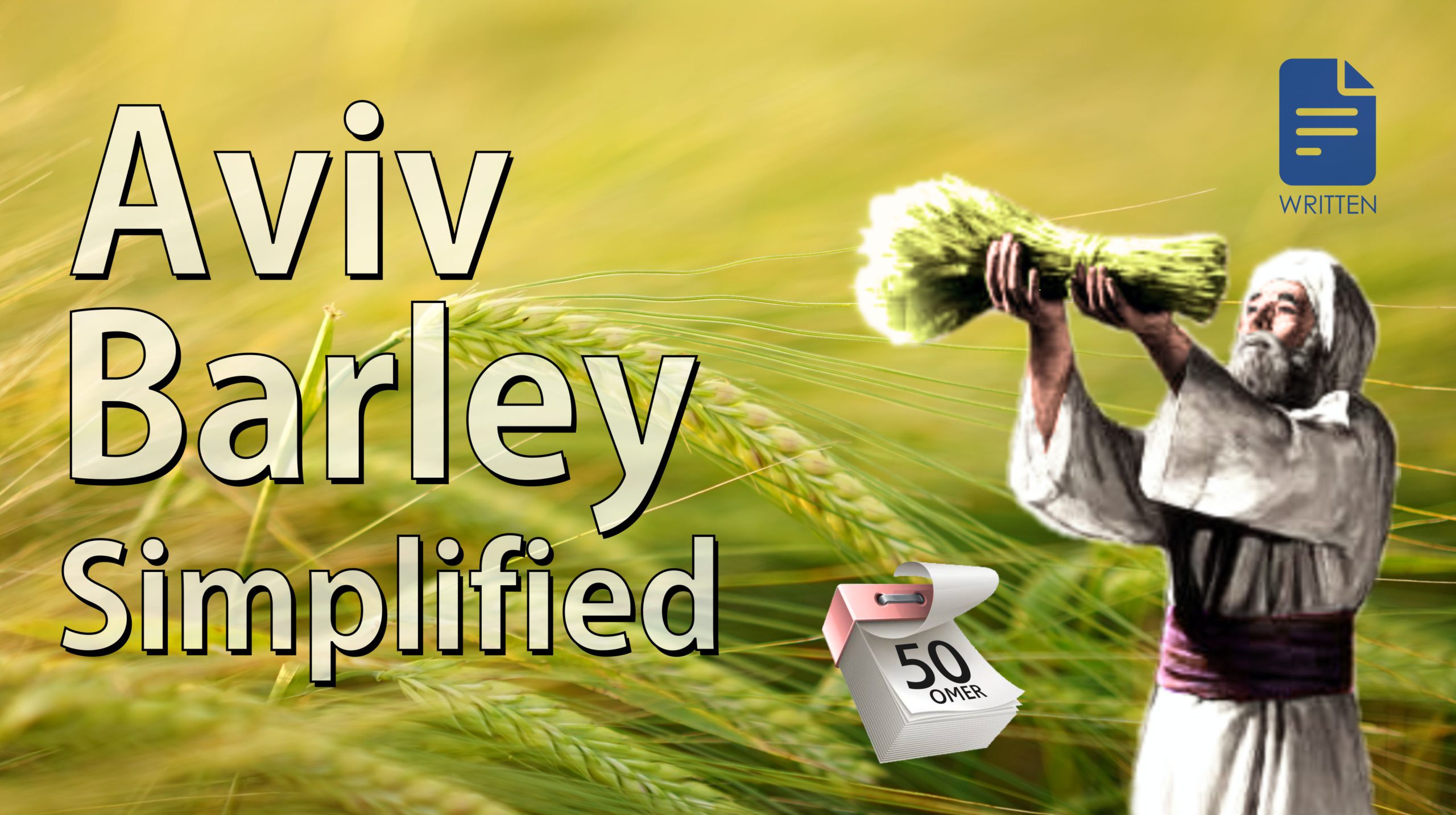
[Study adapted from the video “Aviv Barley Simplified“, from the series Establishing the Head of the Year.]
Every year there are differing opinions about how to start the Hebrew calendar year. How to begin the Hebrew Calendar year is a slightly complex topic. There are many different ideas about how to do it. There are many different voices, and you can tell that there are really a lot of bad teachings out there. If you take the time to think things through, you can see there are a lot of authors that never really stepped things through the way that things need to be stepped out. We can help step those things through for you. But what we thought we should do in this study is, we thought we should put together a simple study covering the basics. For those who want to learn how aviv barley is properly identified and how the head of the Hebrew New Year (Rosh Hashana) is properly declared.
In the Torah the priesthood has the duty to qualify the witnesses to the aviv barley. And then, when there are enough qualified witnesses, then they have the duty of declaring the Head of the New Year (Rosh Hashana) based on those witnesses to the aviv barley. The goal of this study is to help you understand how we qualify the witnesses to the aviv barley, so if that is something you would ever like to do, then you will know how to do it. And for more details I would encourage you to get a copy of the Torah Calendar Study. You can read it for free on the Nazarene Israel website. You can also download a pdf for free or you can purchase it at our cost on amazon.com in a printed paperback copy.
But the feasts are something very important. All believers in Yeshua need to know about the feasts because the feasts (the appointed times or the moadim) are essentially dates with our Husband Yeshua. And if we do not want to stand Yeshua up then we need to make the effort to learn how does He keep the calendar. And then we need to make the effort to be there. It is not always easy, there are a lot of people who would like to follow a broad easy road, so to speak. And then there are other things that are a little more difficult to do Yeshua’s way. But, once again, if we do not want to stand Him up, if we want to be there when He is there, we need to learn how He is doing things and we need to do things the right way.
So, some people would like to know what my qualifications are for speaking on these topics. That is certainly a very fair question. So, I was called to repentance on June 6th of 1999, and I have been blessed to be able to follow the Aviv Barley New Moon Calendar since about 2000, 2001. At that time, we used to call it the Karaite Calendar, but the Karaite Calendar is actually somewhat different. It is very close, but it is different than the calendar that is spoken of in Scripture. We are going to talk about some of those differences in this study. I was originally trained by the Karaites back in 2002, 2003. I have grown barley a few times since then, never commercially but just patches of barley to understand the plant and how it works, what barley is all about. I have also watched the Karaites change the way they reckon things. I watched how they changed the reckoning of the New Moon around 2010 CE. Thankfully, we were able to talk them out of that, and they went back to the original method. They have also changed the way they reckon the aviv barley. They did that in 2016 CE and again they did not tell anyone when they did this. They just sort of sprang it on everyone. And that is really a problem because, for example, I was taught that the Karaites have been keeping the same calendar that was practiced in the days of Moses and in Yeshua’s time in the first century. That is really not true.
To give credit where credit is due, they began to study these things in the 1980s. There is a very charismatic Karaite, and he has been very active in restoring, so the Karaites get a lot of credit for this original calendar. But again, they are not keeping the original calendar. And again, they also made changes to the way they reckon the calendar in 2016, and they do not tell you about these things.
But what we need to understand here is we are going to start to focus in on the details. There are three main questions when we talk about determining the head of the year (Rosh Hashanah) based on the aviv barley. There are three main questions we need to ask ourselves. It is a complex topic, but we are going to boil it down.
- What exactly is aviv barley? What are the specifications, how can we know? Because, like I say, there are a lot of different voices, a lot of different opinions. So how do we know what aviv barley is?
- How much of aviv barley do we need?
- When do we need this aviv barley?
Well, these are very important questions. And one of the things is that these questions I guess we could boil them down into what you might call certain positions. So, there are there three main questions, but there are two main positions.
- One is what you might call the pro-Yeshua position. We are going to talk about it in a second.
- The other is what we might call the anti-Yeshua position, which we are also going to talk about.
And ironically, there are even some Messianic groups who are adhering to this anti-Yeshua position. So, let us talk about those now.
With regards to this anti-Yeshua “position”, it is based primarily on the Karaite theology and the Karaite doctrine. But both the Karaites and Abib of God (which is a messianic search group), teach that aviv barley is effectively “harvest-ripe barley”.
If you look in the picture there, you can see just how brittle and just how brown and just how harvest-ready of barley it is that they are looking for.
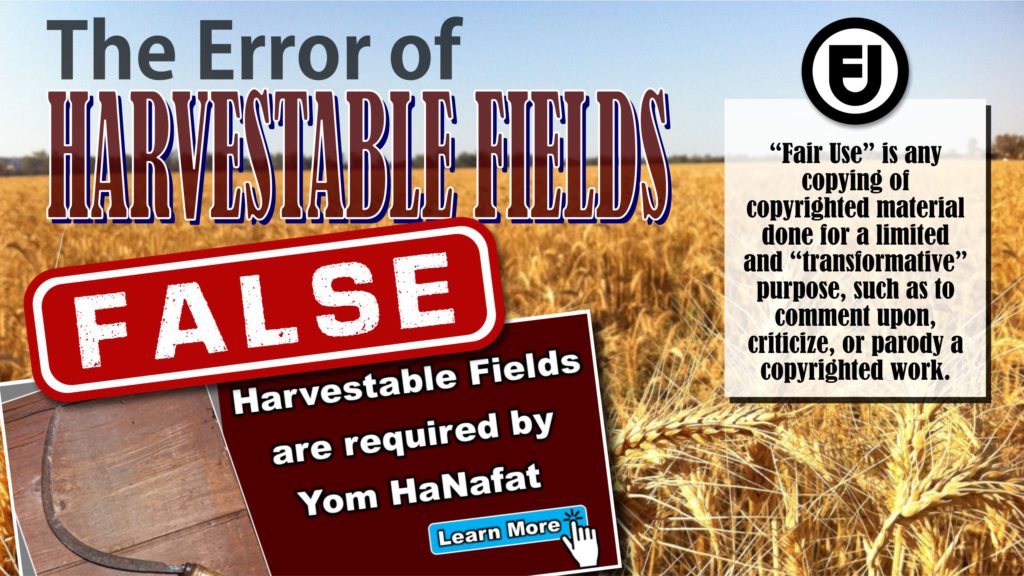
They also teach incorrectly that we want “whole fields” of it. Because what they want to do is, they want to bring in the harvest first, and then they want to bring (what we might call an anti-sheaf) of that harvest to the priest. The main thing to understand is that they are not bringing the first fruits, and we will talk about the definition of first fruits in a little bit. But what they are doing is they are effectively honoring the anti-Messiah, in that Zionist Judah and Zionism means that you do not need to wait for the Messiah. But that the people can serve as the Messiah. So, Zionist Judah came back to the land of Israel in 1948 (symbolic of the harvest) and then they expect to produce an anti-Messiah. This is the general pattern that you see in the anti-Yeshua position. That first they bring in the harvest, and then they produce an anti-sheaf symbolic of the anti-Messiah, and it is not the first fruits. That is the problem here.
So, we can compare this then to the pro-Yeshua position and in the pro-Yeshua position which we take. What we do is we present the very first sheaf of aviv barley. And it is not dry, it is not brown, it is not brittle. But we bring tender, green, young, medium dough, and this is symbolic of Yeshua. We bring that to the priesthood and this honors Elohim by keeping His commandments. And then He blesses the way for the rest of the harvest. And when we do things this way none of the crop has to be lost. And also, we are going to see this follows the pattern that was practiced in Yeshua’s day. First, we bring a sheaf of the first fruits and then this clears the way for the rest of the harvest. Very simple principle, we are going to see it time and again.
Okay, now let us expand this a little bit. So, we just talked about the anti-Yeshua position and the pro-Yeshua position. Now we are going to see these two anti-Yeshua positions. So, these two anti-Yeshua patterns on the top here, and then we are going to talk about the pro position down below.
So, we have the official Karaite doctrine, and this is what they used to teach back in 2016. Maybe they have changed it since then, I do not know. The Karaites do change their doctrine from time to time and they do not announce it. They just go ahead and change it and they let everyone else figure out what has happened.
But the Karaites used to teach that you needed these brown, brittle, dry, harvestable fields to declare even the new moon of the aviv barley. 15 to 21 days in advance of when you have to present the wave sheaf. Two problems here. One is their aviv barley is already so dry and brittle and brown that it is falling out of the head. And the second one is they are saying they need 15 to 21 days in advance.
Well, we see some different voices lately. There is a new study published called Harvestable Fields are Needed by Yom HaNafat HaOmer (the Day of the Wave Sheaf Offering). We talk about this in our video The Error of Harvestable Fields Theory. And this says that they need these whole fields of dry, brittle, brown, harvest-ready barley by the Day of the Wave Sheaf Offering. 15 to 21 days after Rosh Hashanah. This is taught in 2021 by Devorah’s Date Tree (which is effectively a Karaite led interfaith group), and also Abib of God. Again, we believe this is a very incorrect position. Because just take a look at how dry, and brittle, and brown their barley is, and their doctrine calls for having the first fruits (the real first fruits) on the ground. We will see more evidence of that as we go.
But then the third position would be that of doing what Scripture says, which is to bring the very first sheaf of aviv barley (symbolic of Yeshua) on the Day of the Wave Sheaf Offering. We teach this, there is also a sister by the name of Becca Biderman, she and her husband live in the land of Israel. So, we are in that camp and that is the position that we teach. This is to follow Yeshua’s example, and to do things the way things were done in the first century which also matches the patterns that Yeshua walked after.
So, in the Torah CalendarStudy, just to give some basic review, I use these terms interchangeably. So, if I say Rosh Chodesh, we are talking about the Head of the Month (or basically the new moon day). If we talk about Rosh Hashanah, we are talking about the Head of the Year. Now that is a special new moon day, it only takes place once a year. And we hold Rosh Hashanah when we know that we are going to be able to bring a sheaf of barley (the very first wave sheaf) to the priesthood 15 to 21 days after the new moon.

Here you see the new moon (2/13/21) and then the Passover (2/27/21). The new moon can fall any day of the week. But whatever day of the week the new moon falls on, then we would have the Passover 14 days later. For example, if the new moon were seen here (2/8/21), you would have Passover here (2/22/21). If the new moon were seen here (2/10/21) you would have Passover here (2/24/21). But if the new moon were seen here (2/13/21) this year, then you have Passover here on the 27th of February. But no matter what day it is held, then we have the Wave Sheaf on the “first day” of the week, the “following week”.
Okay. So, Rosh Hashanah is when:
- The first crescent sliver of the new moon is seen in the land of Israel.
- We know we are going to be able to present the very first sheaf of aviv (medium dough barley) within 15 to 21 days later on the day of the Wave Sheaf Offering.
What we need to do is we need to make sure we are able to bring that very first sheaf. We do not need whole harvestable fields. It does not need to be dry and brittle and brown. But we are going to bring something that is tender and young and green. And we are going to talk all about that now.
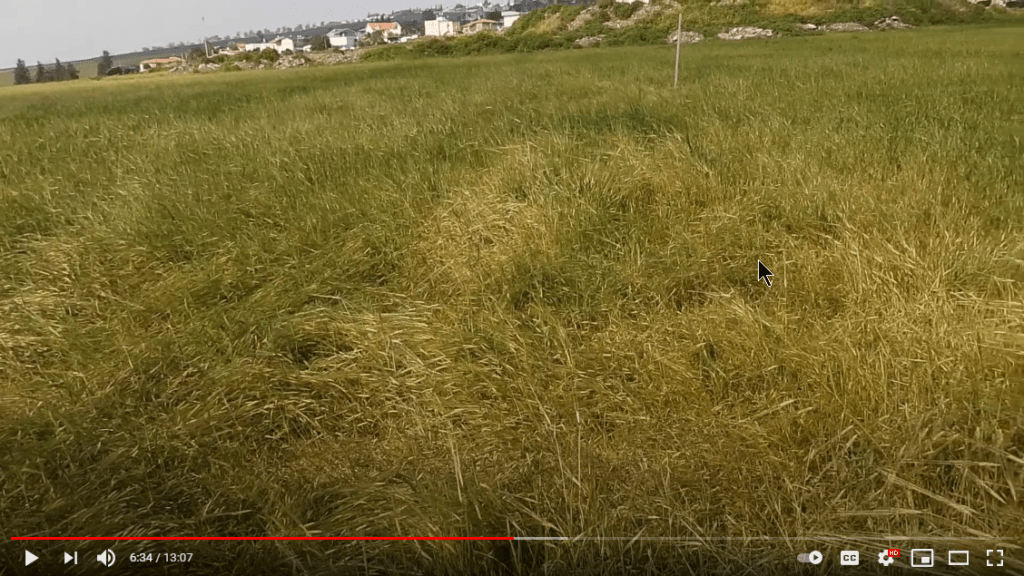
This is a field that was seen by sister Becca Biderman on February the 6th, 2021 (this year). She saw this field near Poriya Illit, and this was approximately one week before the next new moon day (the next Rosh Chodesh).

Here (2/13/2021) is when the new moon was seen. She saw this aviv barley here (2/6/2021), one week before the new moon. And so then on the day of the new moon, she knew, we all knew, that we would be able to bring a sheaf of aviv barley. We knew we would be able to bring the aviv barley 15 days later on the Day of the Wave Sheaf on February the 28th. So, that is what we did.
So, we are going to get into the commandments that explain all this. Why did we do things this way? The first commandment we are going to look at is Leviticus 23:10-11.
Vayiqra (Leviticus) 23:10-11
10 “Speak to the children of Israel, and say to them: ‘When you come into the land which I give you, and reap its harvest, then you shall bring a sheaf of the firstfruits of your harvest to the priest. [Has to be the first fruits, that is what these other groups keep forgetting].
11 He shall wave the sheaf before Yahweh, to be accepted on your behalf; on the day after the Sabbath meaning the Sabbath [of the Passover week], the priest shall wave it.”

In this particular year (2021) here is when the Passover was (on February 27th). It just happened to fall on the Sabbath. And then the Wave Sheaf Offering was offered the very next day on the 28th. If the Passover had happened here (2/21/21), we still would have waited until the day after the weekly Sabbath (first day of the week). Yahweh continues, verse 14.
Vayiqra (Leviticus) 23:14
14 “You shall eat neither bread nor parched grain nor fresh grain until the same day you have brought an offering to your Elohim; it shall be a statute forever throughout your generations and in all your dwellings.”
And there are some of the other groups, they want to go in other directions with this. We talk about this in our other studies. But what we see here is, the basic commandment is, we are to present the very first sheaf of aviv (medium dough barley; symbolic of Yeshua) and Elohim is then pleased. So, then Elohim blesses the harvest and sets it apart. Then after this we can harvest our harvest. This follows the basic pattern going all the way back to the book of Genesis.
B’reisheet (Genesis) 4:3-4
3 “And in the process of time it came to pass that Qayin brought an offering of the fruit of the ground to Yahweh.
4 “Hevel also brought of the firstborn of his flock and of their fat. And Yahweh respected Hevel and his offering…”
Now notice it was not Qayin’s (Cain’s) first fruits, he just brought an offering, kind of like he brought some of the harvest. Nothing special. He did not bring the first fruits of the harvest. It says Hevel or (Abel) also brought of the firstborn of his flock and of their fat. Meaning he brought the very best to “the best”, he brought the firstborn, he brought the very first, to Yahweh. And Yahweh respected Hevel in his offering but he did not respect Qayin’s offering. Because why? Because it was not the first. Well, why the first? Why is the first so important? The apostle tells us that the first fruits represent Yeshua.
Qorintim Aleph (1 Corinthians) 15:20-22
20 “But now Messiah is risen from the dead, and He has become the firstfruits of those who have fallen asleep.
21 For since by man came death, by man [meaning Yeshua] also came the resurrection of the dead.
For as in Adam all die, even so in Messiah all shall be made alive.
22 But [now this is important] each one in his own order: [first] Messiah the firstfruits, [and then] afterward those who are Messiahs at his coming.”
So, once again, we see the basic pattern. First, we bring the Wave Sheaf (we bring the very first of our first fruits), then we can bring in the harvest. If we want to know why some of these other groups do not understand this pattern, we can understand that the Karaites are blinded to Yeshua. So, that is why they would not want to bring the first of the first fruits. What we do not understand is why some of these other Messianic groups do not understand the same pattern. It is a big question for us. But we see that this is even the pattern and the way it was done in the first century.
The famed Jewish historian Josephus, in his book ‘Antiquities of the Jews’ he is talking about the wave sheaf, he is talking about the first fruits offering.
“They offer the first-fruits of their barley, and that in the following manner: They take a handful of the ears [so it does not have to be whole fields, it is just a handful of ears, a small amount], and dry them [this tells us that it is not these brown, dry, brittle barley. It has to be something that is still green. Because why? Because it has to be dried.] Then they beat them small, [we will talk about this when we talk about geres karmel], and purge the barley from the bran [again we will talk about this when we talk about geres karmel]; then they bring one tenth deal to the altar, to Elohim; and casting one handful of it upon the fire, they leave the rest for the use of the priest. [And Josephus says] And after this it is that they may publicly or privately reap their harvest”.
[Josephus: Antiquities of the Jews, Book 3, chapter 10:5:]
Once again, it is the exact same pattern we see. First, we bring the Wave Sheaf (symbolic of Yeshua), and then afterward we may bring in our harvest.
The next commandment we need to take a look at is Deuteronomy 16:9. Yahweh is very clear with this and this is something that the other groups (especially the Karaites), they use all kinds of verses trying to explain away Deuteronomy 16:9. They use verses in Leviticus trying to explain away this passage in Deuteronomy, but that is something that we should never do. That is something we see in the Babylonian church all the time is they use this verse trying to explain away that verse. That is a Babylonian technique, something we should not do, it is something that should not be done. Okay, what does Yahweh Elohim say?
Devarim (Deuteronomy) 16:9-10
9 “You shall count seven weeks for yourself; begin to count the seven weeks from the time you begin to put the sickle to the [standing] grain.
10 Then you shall keep the Feast of Weeks [Pentecost or Shavuot] to Yahweh your Elohim with the tribute of a freewill offering from your hand, which you shall give as Yahweh your Elohim blesses you.”
Very simple principle here. Begin to count when you begin to cut. When we begin to cut that is when we begin to count. And they do not like this, they have all kinds of reasons why we can begin cutting without beginning to count. They try all kinds of things to explain this away. We explain why that is not correct in our video Let’s not Break Deuteronomy 16:9.
But now we need to talk about:
What exactly qualifies as “aviv” barley?
So, let us look at the commandment in Vayiqra (Leviticus) 2:14-15. And there is a lot here, so we are going to come back to this verse again later. There are several things here. Yahweh says this.
Vayiqra (Leviticus) 2:14-15
14 “If you offer a grain offering of your firstfruits to Yahweh [again first fruits, not “part of” the harvest, but your first fruits. We are going to take a look at this word next which is “bikkuwr”.], you shall offer for the grain offering of your firstfruits green [i.e., young] heads of grain roasted on the fire [in Hebrew: aviv kalui. We are going to take a look at that second. And then this “and/ or” does not exist in Hebrew. So, we are going to discuss this a lot] [and/or] grain beaten from full heads [geres karmel. We are going to talk a lot about that near the end of this study].
15 And you shall put oil on it, and lay frankincense on it. It is a grain offering.”
So, “if you offer a grain offering of your first fruits”, that is the main thing. It has got to be the first fruits to Yahweh.
There are several things we need to understand here. When grain is fully ripe it separates easily from the chaff. And in this case the grain is obviously not ripe, since we are bringing green grain (or immature grain, or just barely mature, but grain), it is not yet dry and hard and brittle. What they do is, we will see later, in the modern combine operations they let the barley get completely ripe to where it is almost shattering, almost falling out of the head. And then they come by with a combine, and they slap it, the combine actually shatters the head and it (partially at least) separates the grain from the chaff and these kinds of things. But when you bring the green grain, it does not separate the grain from the chaff. So, you have to manually remove it like that. We will talk about this.
But first we want to talk about the term for “first fruits”. It is Strong’s Old Testament 1061
OT: 1061 Bikkuwr (bik-koor’) (בִּכּוּר); From OT:1069; the first-fruits of the crop: KJV- first fruit)-ripe [figuratively]), hasty fruit.
In other words, this is the fruit that the plant is trying to push out hastily, the very first. We are talking about the very first, we are not talking about something that comes later.
OT:1069 bakar (baw-kar’) (בָּכַר); a primitive root; Properly, to burst the womb, i.e. (causatively) bear or make early fruit (of woman or tree); also
(as denominative from OT:1061) to give the birthright:
KJV- make firstborn, be firstling, bring forth first
child (new fruit).
Again, the birthright goes to the first born. So, once again it bears repeating, that these other groups, they do not bring the first fruits, they bring something other than the first fruits. They bring part of the harvest and they bring what might be called anti-first fruits (pretend or false first fruits). Because it does not truly qualify as first fruits. And we will see that later.
We are going take a look now at the term “aviv”.
OT:24 ‘abiyb (aw-beeb) (אביב); OT:24; From an unused root (meaning to be tender); green, i.e., a young ear of grain.
KJV- Abib, ear, or green ears of corn. [Not corn, not maize. Back then they used the term corn to refer to grain].
The idea here is not so much that the kernel has to be green, the idea is that the kernel should be just mature. It should not be fully shriveled and dried up like when people get older, and their skin is no longer full. In any case, if we take a look at this grain (see image), we can see that it is losing its green. So, here we can see that there is still green to the grain, but the main thing is (we are going to show this later), this is medium dough. The starch content is now the greatest as it is going to be. Here in this, when sister Biderman cut this open with a fingernail, it has got the full starch content here but there is still green. And then in the head there are still tinges of green but yet it is fully mature, it is losing its green because it is mature. It has already packed on as much starch as it is going to pack on.
This is very reminiscent of the prophecy in Isaiah. This is what is called a Remez (or a hint) in Hebrew.
Yeshayahu (Isaiah) 53:2
2 “For He shall grow up before Him as a tender plant [we are not talking about a hard, brittle, brown, dry plant. But as a tender plant]; And as a root out of dry ground. He has no form of comeliness; and when we see Him there is no beauty that we should desire Him.”
Again, let us take a look at this. The plant in the image above is fully mature. It has green, but it is just now starting to turn golden. It has already packed on as much starch as it is going to pack on. So, now it starts to turn golden. It is no longer growing, now it is existing. It is going to start losing moisture. It starts to turn golden because it is no longer growing and no longer needs to be green. Now it is going to become brittle, and brown.
Okay. So, here are some things that we know about aviv barley from what we have just read. We know that we are supposed to bring the very first sheaf of aviv (medium dough) barley symbolic of Yeshua. We also know that by definition Strong’s tells us that it is going to be tender, green, and young barley (or rather just ripe barley). It is going to be a tender young plant. We also know from Leviticus 2:14 that we are going to have aviv kalui. We are going to have green heads of grain roasted in the fire. So, we have got to be able to roast it (to dry it) like Josephus said and that drives the moisture out. Then we have something edible. Well, soft dough can also be edible, but in Leviticus 2:15 it tells us we have to be able to grind it into flour so that we can lay frankincense and oil on it. That calls for a minimum of medium dough. So, medium dough is the thing that makes the most sense. Medium dough has just packed on as much starch as it is going to pack on, and so from here on out it does not need to be a green growing plant anymore. Now it can start to turn yellow, now can start to turn brown, and from there it simply dries and loses moisture. And this is the ideal time to harvest it because there is not going to be any more starch content and the head is not yet brittle.
We also see that medium dough is when barley is viable as seed. And this matches up to the witness in John 12:24 and the pattern in Matthew 27:52 speaking of how Yeshua fell into the earth and died and produced much grain.
Yochanan (John) 12:24
24 [Yeshua says] “Most assuredly, I say to you, unless a grain of wheat falls into the ground and dies, it remains alone; but if it dies, it produces much grain.”
Speaking of the fact that medium dough is viable as seed.
Mattityahu (Matthew) 27:52-53
52 “and then the graves were opened; and many bodies of the saints who had fallen asleep were raised;
53 and coming out of the graves after his resurrection they went into the set-apart city and appeared to many.”
Once again, we are talking about the grain falling into the ground, and dying, and producing fruit; some 30, some 60, some 90. Medium dough is viable as seed.
Now let us focus in on the fact of geres karmel. Let us read the passage again.
Vayiqra (Leviticus) 2:14-15
14 “If you offer a grain offering of your firstfruits [Bikkuwr; Bikkuim; בִּכּוּר ] to Yahweh [must be the firstfruits], you shall offer for the grain offering of your firstfruits green [i.e.; young, tender] heads of grain roasted on the fire [Aviv Kalui; אָבִ֞יב קָל֤וּי] or [and/or- does not really exist] grain beaten from full heads [Hebrew: geres karmel; כַּרְמֶ֔ל גֶּ֣רֶשׂ].
15 And you shall put oil on it, and lay frankincense on it. It is a grain offering.”
Again, this is telling us it has to be at least medium dough. But what this says here; “grain beaten from full heads”, what that is telling us is, we have to manually remove the husk. And that is something that happens when we are dealing with immature barley. When we have fully mature barley, we can slap it with a combine (thresh it) and the chaff automatically separates. But that is not the goal here.
So, we have other groups, the Karaites and the Abib of God, and they are going to tell us that we need to see fully-mature, dry, brown, brittle barley. They are going to rejoice that have barley on the ground. When the first fruits are on the ground the Karaites and the Abib of God are going to rejoice, which we find completely not understandable. But here, let us take a look at the word in Hebrew for geres.
It is from an unused root meaning to husk. So, “geres karmel” means something has to be husked.
OT:1643 geres (gheh’-res) (גֶּרֶש) ;From an unused root meaning to husk; a kernel (collectively), i.e., grain:
KJV- beaten corn.OT:1644 garash (gaw-rash’); A primitive root; to drive out from a possession; especially to expatriate or divorce:
KJV- cast up (out), divorced (woman), drive away (forth, out), expel, surely put away, Trouble, thrust out.
So, that is the term geres, the grain has to be expelled, it has to be cast out. The grain has to be beaten out; it has to be husked.
Now we look at the root OT:3754 “carom”, from an unused root of uncertain meaning. It is very important; they do not really know what it means. It is an unused root of uncertain meaning. But they think it refers to a garden or more likely a vineyard. We believe it has to do with grapes and vineyards.
OT:3759 karmel (kar-mel’) (כַּרְמֶל); from OT:3754; a planted field (garden, orchard, vineyard or park); by implication, garden produce:
KJV- full (green) ear (of corn), fruitful field (place), plentiful (field).OT:3754 kerem (keh’-rem); from an unused root
of uncertain meaning; a garden or vineyard:
KJV- vines, (increase of the) vineyard (-s), vintage. See also OT:1021.
Now in order to understand how this all fits together, first we need to learn more about the growth pattern of barley. So, this particular chart comes from the University of Wisconsin. One thing that we should emphasize is that the University of Wisconsin (obviously) is in the Midwest America. That is very different than Israel which is in the Middle East. And so, we have to be very careful with this chart because not everything applies directly across. In fact, even within the state of Wisconsin every field is different. Every farmer is different, every year is different, the irrigation patterns are different, the rainfall is different. Everything is different, the plants are different. All these things are different and again Israel is not Wisconsin. So, we have to bear with that, but it has some very good, some very important information here.

Now bear in mind this is based on normal Wisconsin hot-spring weather (about 80°F or 26°C).
So, what we see here is the plant is going to emerge from the soil at about day 10 and then it is going to grow and grow and grow and a little bit more. Then in a little bit more than a month we will have the flag leaf. And it is going to grow and grow and grow. And again, in about two months-time or 58 days (this chart is not in scale time wise), we have about a month to here (before the flag leaf), and about another month to here (58 days). So, then at just under two months (58 days) we have what is called the emergence of the head. The head of grain will emerge from the plant and then it will flower. Now it goes on another month and it is going to reach what they call maturity (at 89 days). We need to understand that this is “full combine ripe”. This is a very different thing; this is something they did not practice back in ancient times. Yeshua did not drive a combine, King David did not drive a combine, Moses did not drive a combine. Back in those days they did not use a combine to bring in the harvest, they used a sickle. We are going to see again later, when you harvest with a combine you actually want the barley to be very old, (fully mature). You do not want young barley; you want fully mature barley because you want the plant to be brittle. You want the plant to be easy to break. When you slap it with the combine the whole thing shatters and separates. But that is exactly what you do not want when you harvest with the sickle. Because if you hit it with the sickle and the plant shatters, everything is going to end up on the ground. And you cannot go harvest your crop with a vacuum cleaner or with tweezers. It does not work like that.

But this is a good chart. Here we have the emergence of the head on day 58 and then only 31 days later you have full maturity (full combine ripe). Now again it depends on the field, it depends on the weather, it depends on the year, depends on a lot of different factors. But about two-and-a-half-weeks after the plant flowers it is going to reach a state we call “aviv”, and that is medium dough barley. Okay, now we are going to zoom in on this “31-day stretch” (between the 58th and 89 th days). We are going to zoom way in on this.
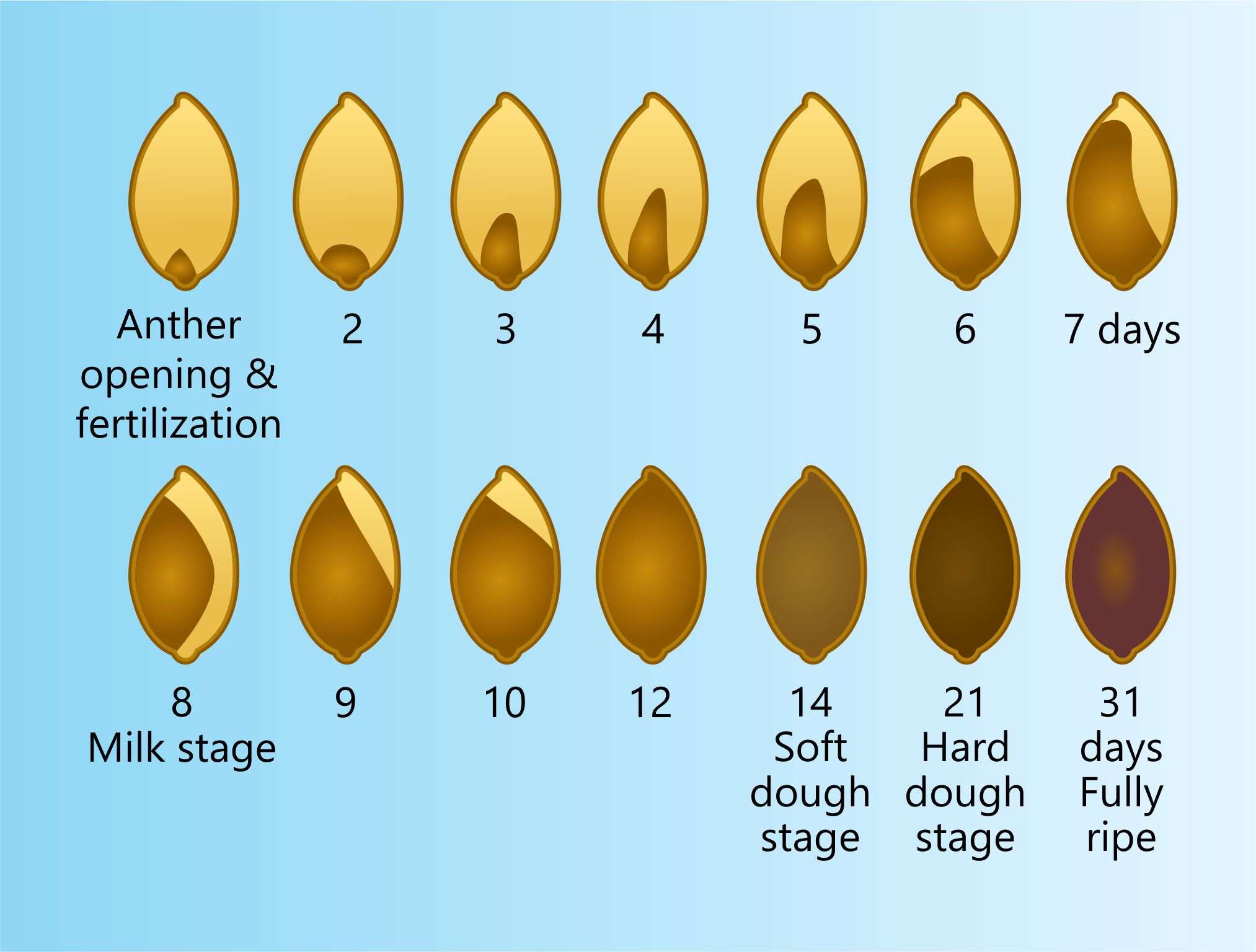
This is from the point of view of the seed itself. Here (day 1 of 31) you have the flowering.
- The flower is going to open up and it is going to be fertilized. Then it is going to close, and it is going to form a seed pod.
- Then you have what is called the water stage. The first 7 days is what can be called the water stage. We will see here as that dark brown, the plant packing in starch. It is going to pack on more starch and more starch and more starch within this first 7 days.
- And after about 8 days it then reaches what is called the milk stage. This does not really look like this inside, but if you were to rip this open you would see something that looks like milk.
- And then you give it some more time and then now you are going to enter what is called the worm phase (about day 10). If you were to cut off one end of this and squeeze it or if you were to open this up, you would see what looked kind of like a very slimy worm.
- Well, it is going to continue packing on starch until about day 14. Now it is going to have the consistency of what might be called soft bread dough. If you have ever made bread, you can get a feel for what soft bread dough would be like, that is what it is about day 14.
- Give it a few more days, (again depending on the weather, depending upon the field, depending upon the rainfall, depending on a whole lot of different factors). Then you are going to reach a state that is called “aviv”. That is aviv (what we call medium dough). Here in between days 14 and 21. (Between 2-3 weeks after the head’s emergence).
- And then at 3 weeks (21 days) it is going to enter what is called the hard dough stage.
- And then give it 31 days (give it another 10 days), and that is when it is “fully combined-ripe”.

Now hard dough, that is about the 21st day, that is about the very upper limit of what you want to be harvesting with a sickle. You want to be harvesting here (after day 14), when it is medium dough. That is as much starch content as you are ever going to have. And then after about 21 days things are starting to get brittle. By the time you get to 31 days you cannot harvest with the hand sickle anymore, it is just too brittle.
Now I wish I had more pictures than this, but these are the pictures that I have. Here is another view of this, listed by figures A-F.
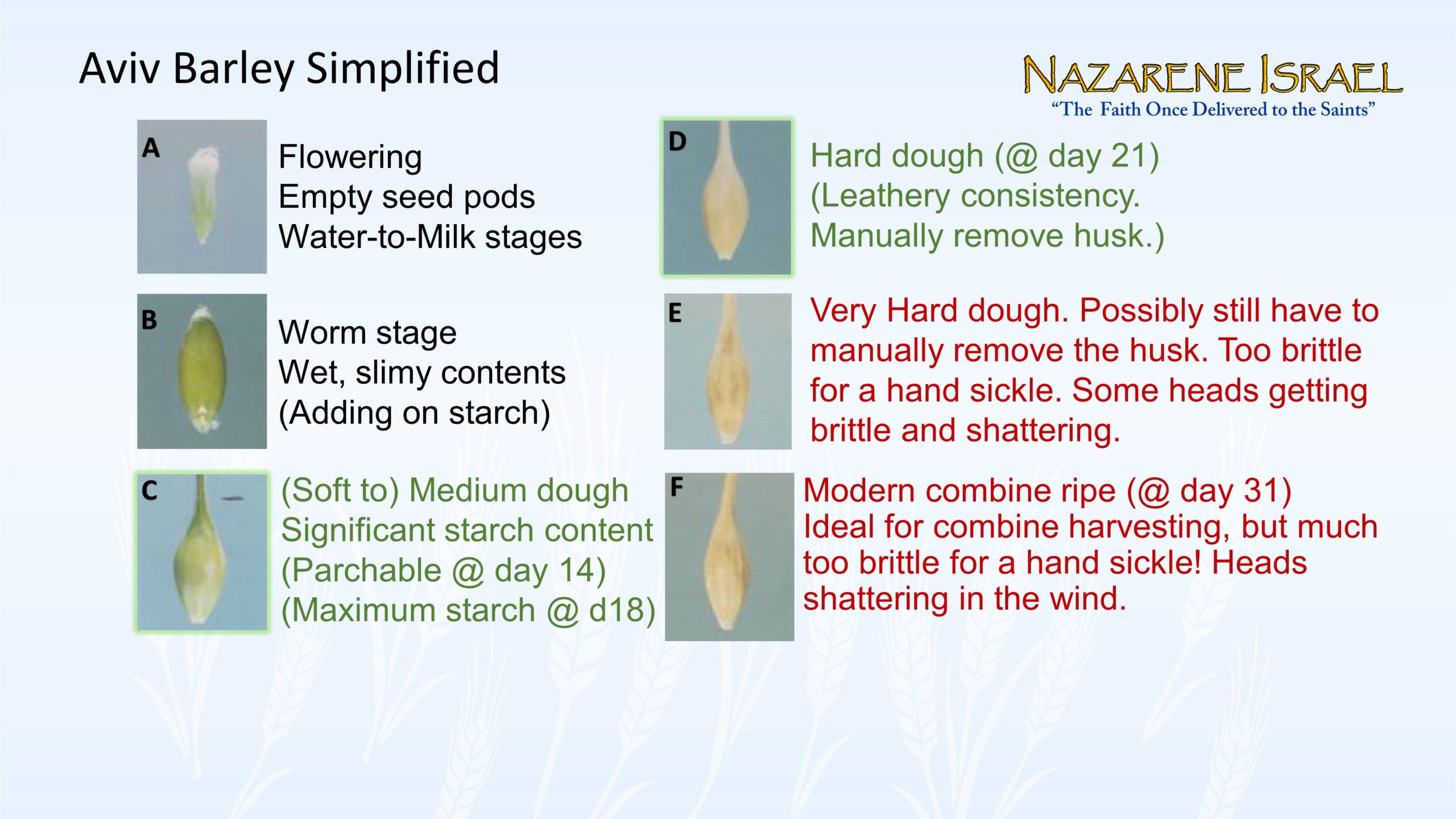
A. Here you have the flowering. After the flowering you have the empty seed pods, and you have the water and the milk stages. So, it is not really very full.
B. But then by the time you reach the worm stage (about day 10 or 11, 12 depending on the field), if you were to tear that open you would have wet slimy contents. Or sometimes people cut off the end and squeeze it and what pops out looks like a slimy worm.
C. Give it some more time, and again you cannot really judge based on the color, but do you see how full this is here? This is somewhere from soft to medium dough. It was not inspected, but you can see how full it is. You would open that up and then you would inspect the contents. You would check it and see. If it is still wet that is soft dough. If it is it no longer wet but it is not yet hard and leathery, then that is medium dough. It is parchable when it is soft dough but what you want is medium dough. Because that is grindable into flour. So, you end up with your maximum starch content about days 17 to 18 according to the University of Wisconsin chart. But again, you have to open it up and inspect it. You cannot just go based on color or looks, you have to physically open it up and inspect it. But, once again, you see how it is. Is it is starting to lose its green? because it is coming to stop packing on starch.
D. Here we have hard dough, this is about day 21. Do you see how this is thinner than Figure C? That is because it has got the same amount of starch, but it is starting to lose its water content.
E. Give it a few more days and it gets even harder. (Very hard dough).
F. And then you give it even more time, this is about day 31, (modern combine ripe). It has gotten so dry. You see how even the head starts to crook over? Because it is drying that much that the awn is starting to tilt, the awn is starting to lean a certain direction.
Now by the time you get into very hard dough and “modern combine-ripe”, this is way too brittle for a hand sickle. This is one of the things that we just need to get through to some of these other groups. They just do not understand this. They are looking for dry harvestable barley and they are rejoicing when they have first fruits on the ground. These things just are not right.
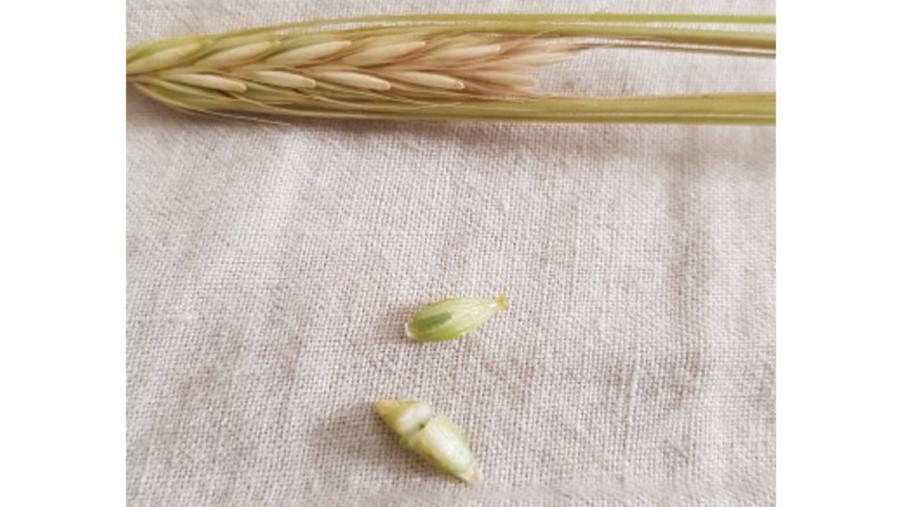
So, let us take a look at it again. Here is medium dough barley. It has still got a slight hinge of green, there is still a little bit of green going on here. But you see how it is starting to turn golden? Okay, starting to turn golden. It has got a full consistency; it is neither wet nor is yet leathery. And you see how it is starting to turn golden and there is just still a little bit of green. It has got the maximum starch content that it is ever going to have. But then when you hit it with a sickle it is not yet going to shatter, you are not going to lose your crop on the ground. And then you can dry it later.
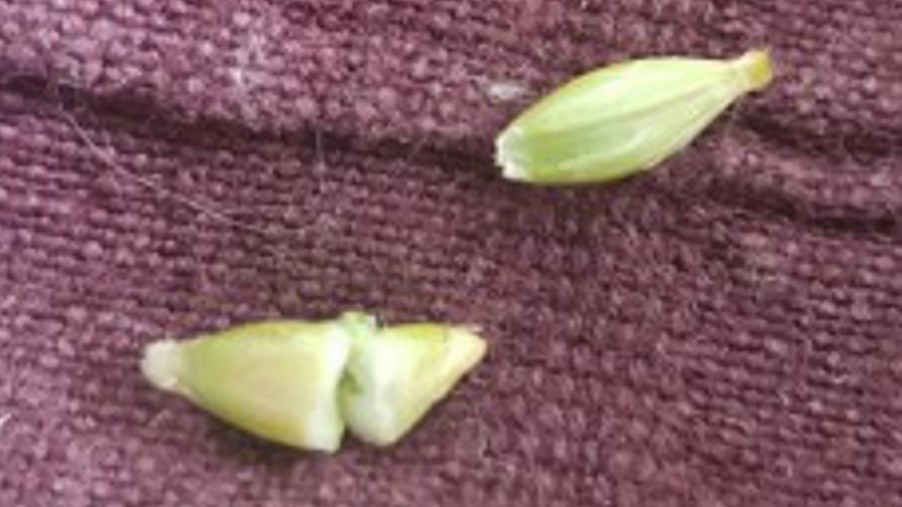
Here is another view. So, this is a different grain. It has been cut open. You can kind of see the consistency there. It is still green. Again, so, Becca Biderman emphasizes you cannot go by the color. But can you see how it is full? It has got a medium dough consistency, that is medium dough.
Okay, now here is hard dough from sister Becca Biderman. She found hard dough in 2019 and she considers this field to be fully harvestable.
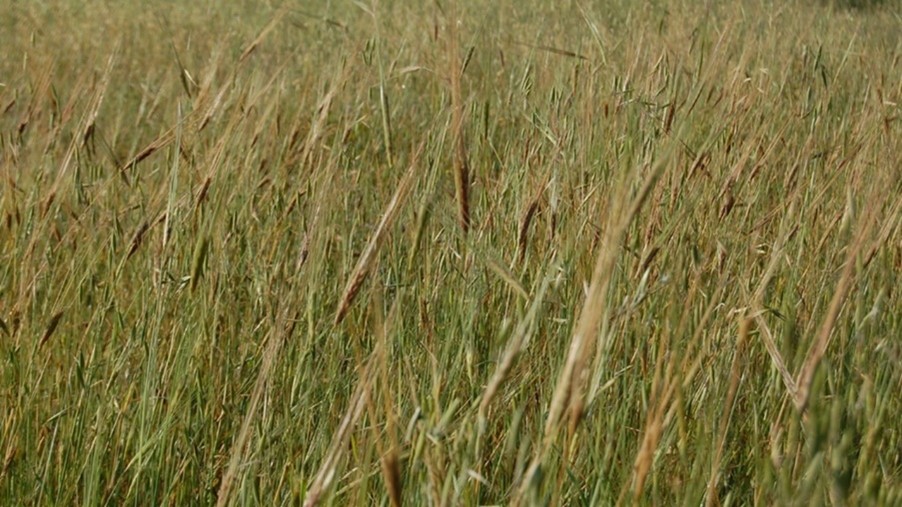
This is about as late as you want to harvest. Any later than this, you are going to gather the stalks together and then hit it with your sickle, and you are going to shatter the barley. You are going to lose part of the barley out on the ground and oh, basically you lose that part of the crop. That is what you want to avoid, particularly in ancient times, it is a very different harvesting process to harvest by hand sickle. And if you were to open these grains up you would have something that you could still cut it with your fingernail, but it would be a very tough, very leathery-like consistency.

Now in the image above, we have on the left, (and again it depends, you just have to inspect it), but here is your green immature aviv barley. Here (center) is some barley that some of the other groups are calling aviv. And that is not aviv, that is too brittle. If you are going to harvest that with a sickle, you are going to lose a large part of the crop. And then on the right is barley that was accepted as aviv in 2017 by one of these other groups. And that barley is going to go on the ground, some of that barley is on the ground already. So, that is no good.
Well for some reason these other groups seem to have what we call a combine-ripe mentality. Like we mentioned before, with a combine you want the barley to be brittle. Because you literally come by with a scoop and you hit the barley with the paddle, it paddles the barley into the scoop, and the barley is harvested. It is hit and then it shatters and then you separate the barley from the chaff. And all these things, you can do that when you have a combine, but you cannot do that when you have a hand sickle. When you have a hand sickle you are going to gather the stalks together and hit it with a sickle, and some of that barley is going to fall right there on the ground. Ancient sickles were nowhere near as sharp as modern steel sickles.

The top sickle (assumably flint) was found in the land of Israel. Then the sickle below is possibly bone or something pitched into a piece of wood. I do not believe it is from the land of Israel, but nearby, possibly from Syria or Iraq. It was somewhere near the land of Israel. But these are the sickles they had to work with in ancient times. So, what you are going to have? You are going to have a lot of what we call “sickle-shock” when you gather those stalks together and hit them with that sickle. The barley sheaf is going to undergo a lot of shaking. If the barley is fully brown like these other groups want, you are going to lose a lot of that barley. It is going to fall out of the head, and you do not want that. You want it when the barley is full, when it has reached medium dough. It has got as much starch as it is going to get but yet the head is not yet brittle. And that is why Yeshua teaches us this in Mark 4:28-29.
Marqaus (Mark) 4:28-29
28 “For the earth yields crops by itself: first the
blade, then the head, and after that the full grain in the head.
29 But when the grain ripens, immediately he puts in the sickle, because the harvest has come.”
And just for a little bit more detail on that, with the barley head, you are going to have the seeds below. Then the tip grain probably will be hard dough. That is when the rest of the barley head is going to be medium dough. So, when the tip is hard dough and the rest of the grains are medium dough, that is the time you want to harvest. Because that is when you are not going to lose your crop.
Now, some of the other groups, they have some very strange doctrines. Again, they want to see these fully uniform harvestable fields. Again, it is kind of like a combine-ripe mentality, like they think they are going to bring their combine by and harvest everything all in one day. That is just simply not how it happened. If you have to get out there in a field, if you have a field of any size, then you are coming with a sickle. You can only advance so much in a day. You need to start early, and it is actually a blessing if the field comes ripe non-uniformly because if the field comes ripe all together at once you are going to start to lose barley. It is going to fall on the ground before you are able to get it harvested. And some of these other groups, what they want is not logical.
Here we have again, this is sister Becca Biderman’s field in Poriyah Illit and she found this barley on the 6th of February. This in the Galilee region in Israel.
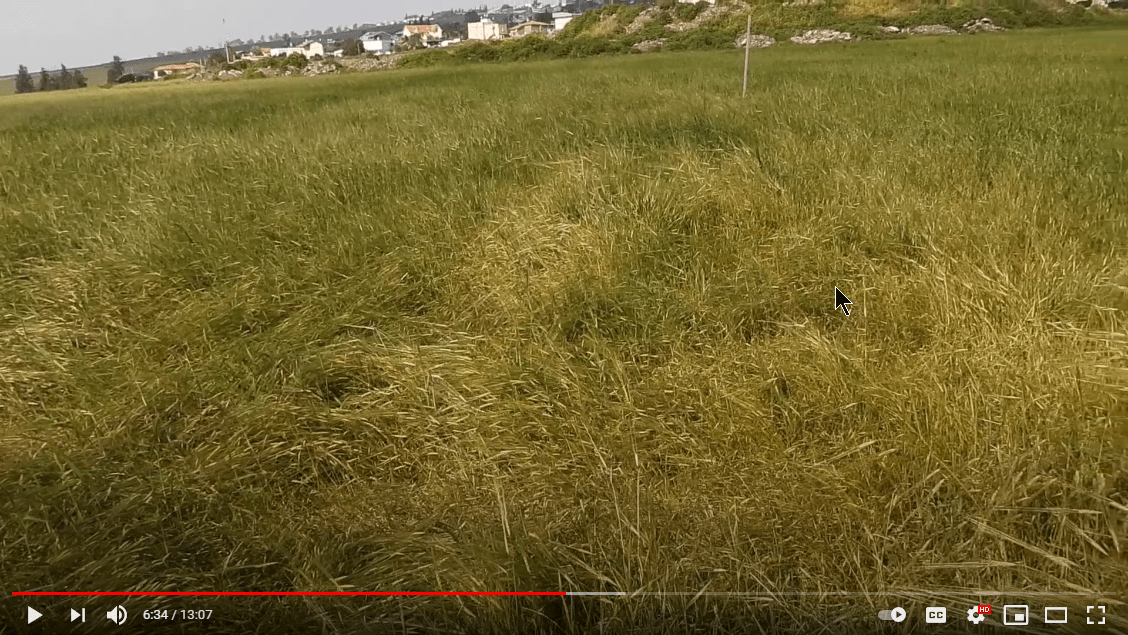
You see this barley in the foreground? It is starting to lose its green. So, that is when you know to inspect it for medium dough. You cut the grain open, and you check the consistency, that is how you do it. When the tip is hard dough and then the other grains are medium dough, that is your aviv right there. And you notice how this field is coming ripe in patches. That is what you want because it is going to take you time to harvest this field, it is going to take you time. If this whole field were to come ripe all the same time you would not be able to harvest it before the grains fell to the ground. So, you want the fields to come ripe in patches. Yet we have Abib of God who likes to reject fields if they are not uniform and perfect. So, we do not understand the logic behind that and let me just leave it there. Let us just not say anything more than that right now. But that is why the wise farmer, when he sees the barley is ready, he immediately puts in the sickle. Because the harvest has come.
Okay, now we need to talk about geres karmel. Now that we understand the growth patterns of the barley we can discuss:
What does geres karmel mean?

So, this is what an Ancient Israelite would have called a mortar and a pestle. Because the first fruits of grains are still wet you have to dry them, typically in a fire by roasting. Then after that you have to manually remove the husk. Removing the husk qualifies as geres.
OT:1643 geres (gheh’-res) (גֶּרֶש) ; From an unused root meaning to husk; a kernel (collectively), i.e., grain:
KJV- beaten corn.OT:1644 garash (gaw-rash’); A primitive root; to drive out from a possession; especially to expatriate or divorce:
KJV- cast up (out), divorced (woman), drive Away (forth, out), expel, surely put away, Trouble, thrust out.
So, we are talking about husking or taking the grain out of the husk. This is again what Josephus speaks about in his book Antiquities of the Jews.
“They offer the first-fruits [not second fruits, not part of the harvest, first fruits] of their barley, and that in the following manner: They take a handful of the ears [not a lot, a wave sheaf, a handful], and dry them [meaning still moist, just like medium dough is still moist], Then they beat them small, [talking about the mortar and pestle], and purge the barley from the bran [talking about geres here, the procedure that goes on in the mortar and pestle]; then they bring one tenth deal to the altar, to Elohim; and casting one handful of it upon the fire, they leave the rest for the use of the priest. [And Josephus says] And after this it is that they may publicly or privately reap their harvest”.
[Josephus: Antiquities of the Jews, Book 3, chapter 10:5:]
So, once again, it is the same pattern we see over and over and over again. First, we bring the wave sheaf symbolic of Yeshua, and this clears the way for the harvest. Then we may bring in the harvest, not the other way around like some of these other groups are teaching. Okay, let us continue on to karmel.
OT:3759 karmel (kar-mel’) (כַּרְמֶל); from OT:3754; a planted field (garden, orchard, vineyard or park); by implication, garden produce:
KJV- full (green) ear (of corn), fruitful field (place), plentiful (field).OT:3754 kerem (keh’-rem); from an unused root of uncertain meaning; [very important, uncertain meaning, they do not really know what it means]. a garden or vineyard:
KJV- vines, (increase of the) vineyard (-s),
vintage. See also OT:1021
This is very important. In December of 2020 and in the first half of January 2021, in the land of Israel it was exceptionally sunny and warm. It was unseasonably hot and the barley in Israel (of course it is dependent upon the weather), it began ripening very early. So, we had this six-week advance toward ripening. Some of the barley actually reached flowering stage and it pollinated and fertilized itself. For plants that is pretty much the point of no return. If you have ever seen a warm spring, sometimes the plants can start to push out buds and then if it gets cold, they pull the buds back in again. But once a plant flowers and pollinates itself it has pretty well reached the point of no return.
Well, then after the six weeks it got cold again. So, the barley that had pollinated formed what might be called the first flush of barley. And this was a very early spring. This was long before the spring equinox and spring (which again is dependent upon the spring equinox). So, we saw some very interesting patterns in the land of Israel this year. We are going to see even more interesting things.
So, we have sister Becca Biderman’s field that we saw on the 6th of February. Now that field, that barley was aviv. That particular field was bulldozed but it would have been shattered and, on the ground, long before the Karaite Wave Sheaf Date. That particular field would have had to have been offered at the Wave Sheaf date of February the 28th. There were two other fields, (she might have found others) but there were at least two other fields that I am aware of that sister Biderman found around the 22nd of February. And those fields were both shattered on the 19th of March (the day before the spring equinox).
Now you have the equinox people. You have Abib of God, you have Devorah’s Date Tree, the Karaite theology, they are all holding their Wave Sheaf Offering here on the 4th of April which makes no sense. How can you offer your first fruits of barley when they are already shattered and on the ground? The answer is you are offering something other than your first fruits. What are you offering? If your first fruits shatter and go on the ground then when you have a later Wave Sheaf, you have to offer something other than first fruits. It is not “the first fruit of woman or plant”, it is not “the fruit that opens the womb”, so to speak. It is not your firstlings; it is something else. It is just part of the general harvest, anti-first fruits, pseudo-first fruits, pretend first fruits. That is something these other groups really need to wrestle with. They need to deal with that fact.
Okay. We had this early spring. We had six weeks of hot weather in the land of Israel, and again once the barley has flowered it is really committed. It has reached the point of no return. So, the barley plants are going to go ahead, and they are going to push forth and create seed no matter what else happens. And because of the climactic stresses Becca Biderman found short barley stocks which had produced heads. She found this barley around the Reim area down near the Gaza strip.
They had a very small number of grains in the head, maybe only two or four grains. But if you are a barley plant and you have already flowered what else are you going to do? You are going to attempt to push forward as best as you can to recreate seed for next year. That is exactly what the barley plants did.
Now with exceptional stress like we had in 2021, when barley is exposed to climactic stress it can do a number of things. One of the things that barley is known for is that it can also change color it can turn blue or purple or basically wine colored. It can turn what might be termed karmel, and this is due to the presence of what are called anthocyanins.

The term cyan means blue. In other words when barley is exposed to stress it is going to turn blue. That is what it does. Those are called anthocyanins or might also possibly be karmel.
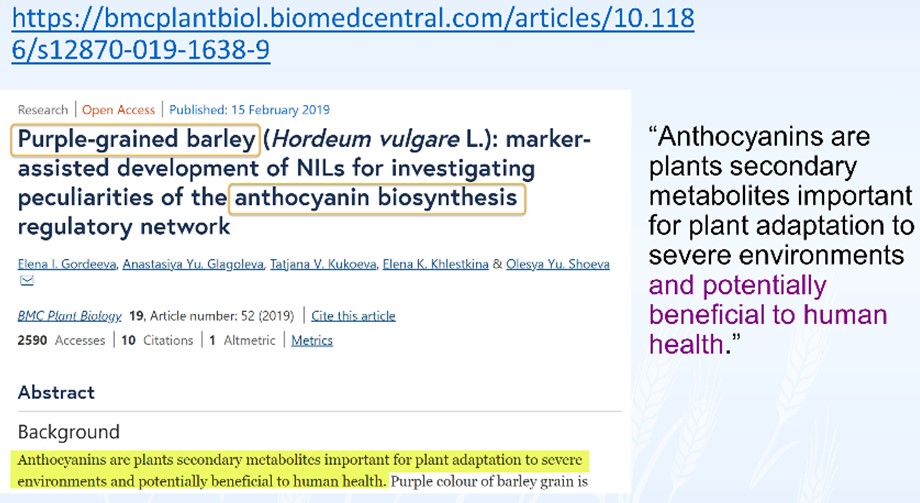
Now they have done some studies on this. This study was published on the 15th of February 2019. There is the URL if you want to look it up, but it is talking about the Purple-grained barley and the anthocyanin biosynthesis. And what it says is that “anthocyanins are plants secondary metabolites that are important for plant adaptation to severe environments and potentially beneficial to human health.”
Who could possibly imagine the correlation between the stress Yeshua went through and human health? So, to speak, if you can catch the symbolism there. But researchers are now trying to find new ways to make barley and other grains generate anthocyanins because the anthocyanins are so beneficial to human health.
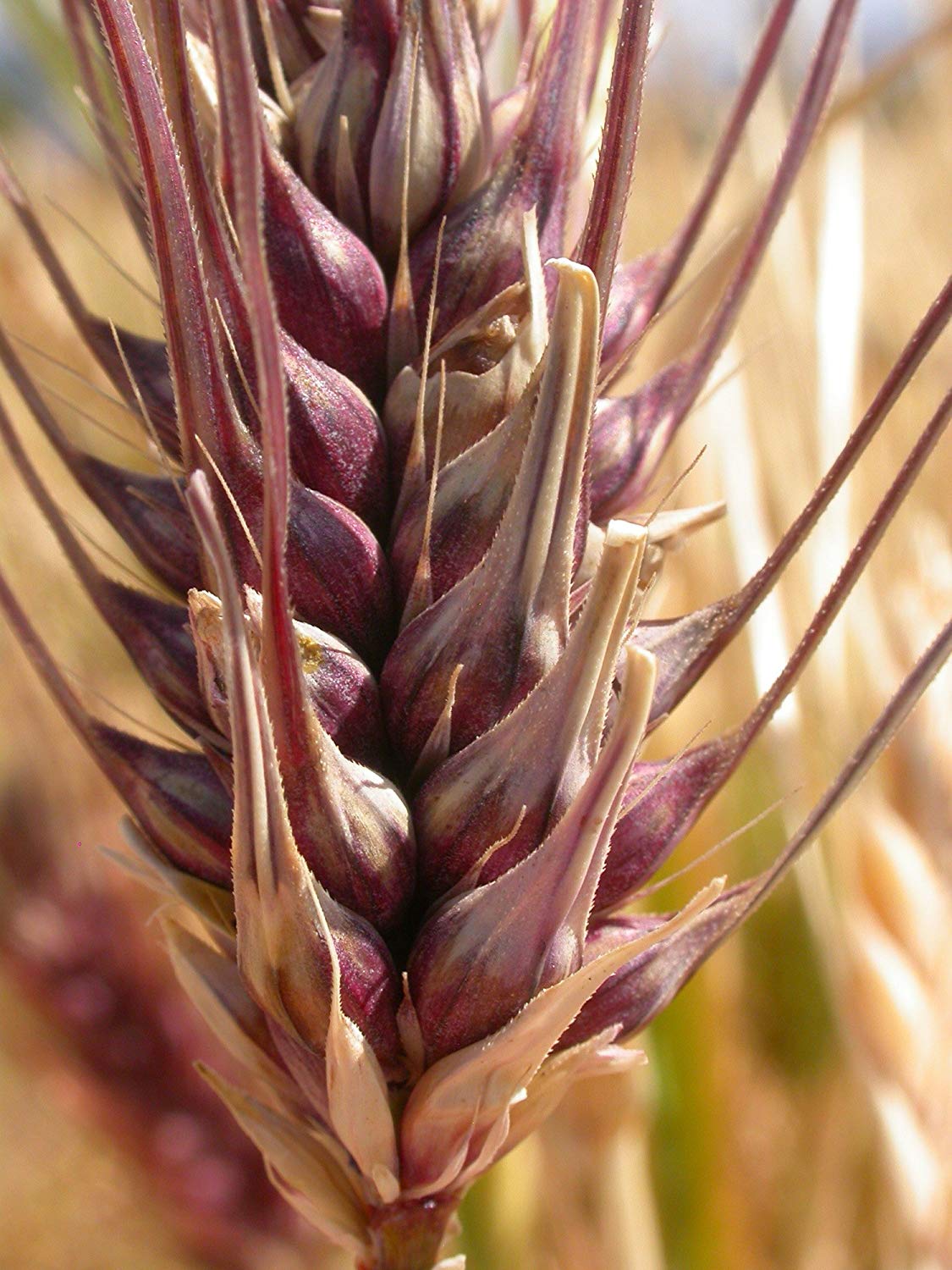
What we are really saying here is that they are getting into genetically modified organisms and these kind of things, and we do not agree with genetic modification of plants at all. But we agree with anthocyanins and this is very interesting.
So, here is some purple barley that sister Biderman found in Israel in the spring of 2021.
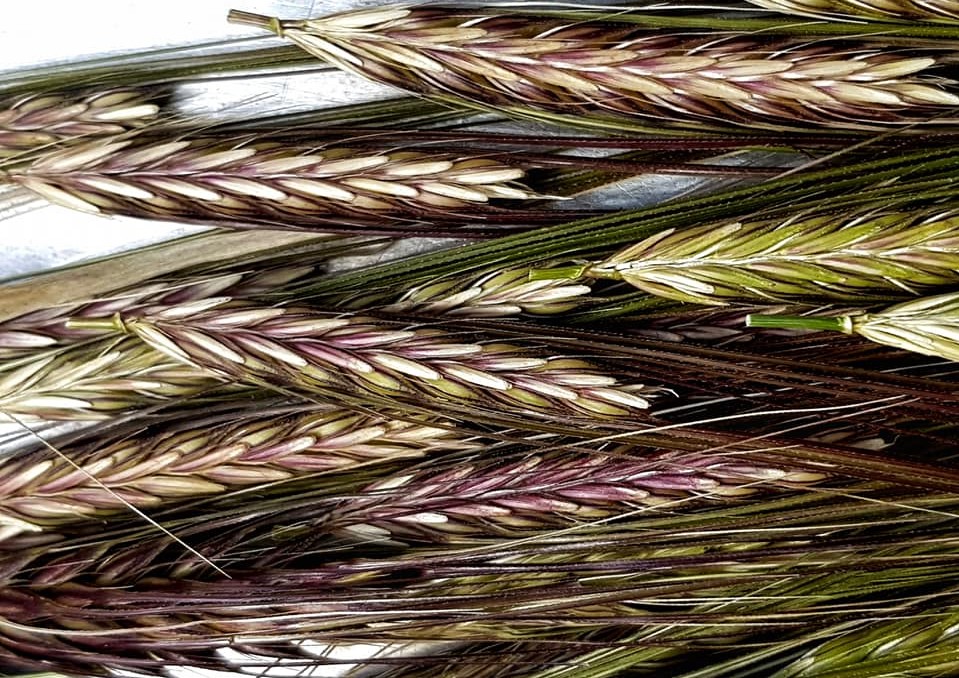
Could this possibly be karmel barley (barley that is the color of the blood of grapes)? Let me share a few verses with you.
Here is what might be called a remez (or a hint) in Genesis 49.
B’reisheet (Genesis) 49:10-11
10 “The scepter shall not depart from Judah, nor lawgiver from between his feet, until Shiloh [Messiah] comes; And to him [meaning Mashiach] shall be the obedience of the people.
11 Binding his donkey to the vine, and his donkey’s colt to the choice vine, He washed his garments in wine, And his clothes in the blood of grapes.”
We could take a look at another hint in Isaiah 53.
Yeshayahu (Isaiah) 53:4-5
4 “Surely He has borne our griefs and carried our sorrows; Yet we esteemed him stricken, smitten by Elohim, and afflicted.
5 But He was wounded for our transgressions, He was bruised for iniquities; The chastisement of our peace was upon Him, and by His stripes we are healed.
Can we see the symbolism here in another remez in Luke 22?
Luqa (Luke) 22:20
20 “Likewise, He also took the cup after supper, saying, “This cup is the new covenant in My blood, which is shed for you”.
Can we catch the symbolism of Yeshua as the Wave Sheaf of barley? This brings us back to Leviticus 2.
Vayiqra (Leviticus) 2:14-15
14 “If you offer a grain offering of your firstfruits [בִּכּוּר] [symbolic of Yeshua; your bikkurim] to Yahweh, you shall offer for the grain offering of your firstfruits green [young or immature] heads of grain roasted in the fire [aviv kalui; אָבִ֞יב קָל֤וּי] [and/or] grain beaten from full heads [כַּרְמֶ֔ל גֶּ֣רֶשׂ] [meaning you have the husk removed, or it could be the symbolism with the karmel].
15 And you shall put oil on it, and lay frankincense on it. It is a grain offering.”
So, the point here we are trying to make is that no matter whether karmel refers to purple barley or not, we need to bring tender, young grain. We need to bring it when it is still tender, so that it needs to be roasted in the fire and have its husk manually removed. This does not happen if we wait until the barley is already mature as we saw in the previous images.
If the barley is already mature and brown and dropping its seed (as in combine-ripe), then we do not need to physically husk the barley, it threshes just fine. So that is, how shall we say, another nail in the coffin of these other groups’ theories. Just some unbelievable things.

Again, let us bear in mind that in 2021 sister Biderman found aviv barley here (February 6th). That made for Rosh Hashanah (the head of the year), as we already mentioned, was here on February 13th. She found other barley on the February 22nd and then we had Passover on the 27th and the Wave Sheaf offering on the 28th. Now the field where she first found the barley, that again was bulldozed. But that would have all been shattered and, on the ground, long before here (yellow line). And these fields that were found on the 22nd, they were shattered and on the ground on the 19th, the day before the equinox. But now we have still got the equinox people and Devorah’s Date Tree, the theologians, and the Abib of God inexplicably all celebrating their Wave Sheaf Offering on the 4th of April. When the first fruits are already shattered on the ground long before then. Why?
Now the problem is, if we do not bring the very first sheaf of aviv barley symbolic of Yeshua, you are going to be faced with some problems. What has to happen is either:
- The farmers with the earliest ripening barley have to break Deuteronomy 16:9 by harvesting early before the Omer count begins.
- [Or] they are going to lose their crops.
And in ancient times losing your crops means you could effectively lose your land. You might even have to sell yourself and your family into slavery, because that is the way things were. Amos talks about that. That is another thing these other groups need to deal with. They need to be honest about, that their theology would have been a major problem for the farmers. If this were your field right here (February 6th), or if this were your field (February 22nd), and you could not offer the wave sheaf offering on February 28th, that means your barley is going to go on the ground. Because the Karaites, Abib of God, and the equinox people will not allow you to harvest your barley until after the Wave Sheaf Offering that they scheduled for April the 4th. Or according to the Karaites, yeah you can go ahead and harvest it early, but then you lay it aside and so that is breaking Deuteronomy 16:9. Plus there is the fact you are just simply laying it aside, you are not presenting it. Once again, you are not presenting the first fruits, you are presenting something other than the first fruits.
So, in particular, the Karaite model is, well we have a hard time understanding it. The Karaites (or I should say Devorah’s Date Tree?) Devorah’s Date Tree emphasize they are not a Karaite search group, but of course Devorah is a Karaite, and she teaches Karaite theology. They were even boasting about having shattered barley on the ground the day after their wave sheaf offering which makes absolutely no sense. Why would you be proud that you have your first fruits on the ground? Because that is the whole point of the Wave Sheaf Offering, to present the first fruits. Well, they are already on the ground, how can you present them? You need a vacuum cleaner? Your tweezers? What do you do? I do not understand.
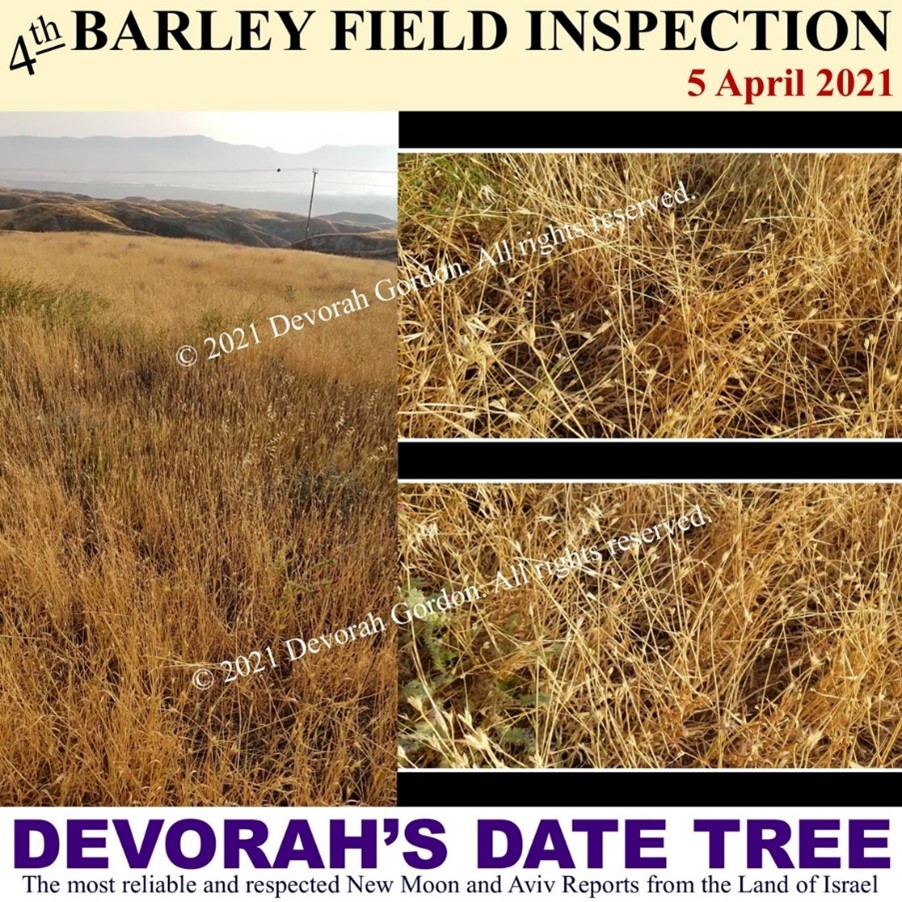
This is a copyrighted image, but we are not presenting it as our own. We are just making comment on it, this is a comment, criticism, and commentary; that is a “fair use”. But take a look, this is the Jordan River Valley. So, she is proud, she is boasting, that they have got shattered barley on the ground on the day of the Wave Sheaf Offering. Unbelievable.
I understand that now Abib of God was the same way. Abib of God is a Messianic group and why they do not understand that they are following the anti-Yeshua pattern, I do not understand. But Abib of God boasts about how they purposefully let the earliest ripening barley fall to the ground. Because they do not like hills and barley usually ripens sooner on the hills than in the valleys. Okay, so anyway, basically they do not like hills, and they will only accept what you might call a “golf course manicured field” (or a combine-ready field), this kind of a thing. It has to be completely uniform; they will not allow it to ripen in patches. And they have made up all kinds of rules that do not exist in Scripture. If you want to know more information about that you can see our video Did Ancient Israelites Qualify Their Barley Fields? You can also read the transcript on the Nazarene website. But they make up all kinds of rules that Scripture says absolutely nothing about.
Once again, they are saying they have got shattered barley on the ground before the day of their first fruits offering. Therefore, by definition, they are offering something other than their first fruits on the day of the Wave Sheaf Offering which makes absolutely no sense. How can you present your first fruits when they have already fallen to the ground? Enough said. Let us just leave it there.
So, we understand why the Karaites do not understand the need to follow the pro-Yeshua model. Because the Karaites, by definition, they are blinded to who Yeshua is. But for the believers in Yeshua, those who are following the Karaite model of wanting to bring in the harvest first and then to produce an anti-sheaf (symbolic of the anti-Messiah), why are they doing that? We do not understand that. You are waiting, you are not bringing the very first sheaf of aviv barley; when the barley is aviv here on February 6th and then also aviv on the 22nd. If you do not bring those on the day of the Wave Sheaf offering on the 28th it is one of these reasons. Because either you are waiting for the equinox (meaning you are making your decisions based on the sun, which is sun worship). Or you are following the anti-Yeshua pattern of bringing in the harvest first and then producing an anti-sheaf. Which is not what Scripture says to do and it is not what Josephus says was done in the first century. So, why are we doing that? Why would a Messianic believer in Yeshua Messiah do such a thing when it follows the completely wrong pattern? We do not understand.
If you would like to know more, please go to the Nazarene website nazareneisrael.org and read or download the Torah Calendar. You can also purchase a copy at our cost in paperback form on amazon.com. Or you can go to the Nazarene Israel YouTube channel and you can watch our videos on the barley listed there on a variety of topics. And hopefully this will help people to understand why things need to be done the way they were done in the first century, and exactly how it was done in the first century.